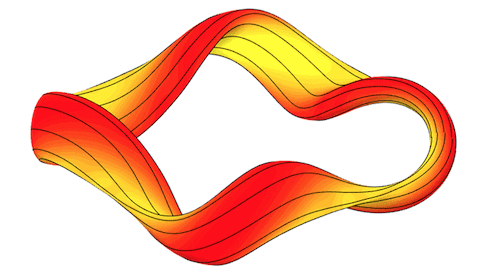News Story
UMD Scientist Helps Fuel Hopes for Nuclear Fusion

UMD physicist Matt Landreman (below, right) and research partner Elizabeth Paul Ph.D. '20, a Princeton University postdoc, made a breakthrough in the design of stellarators—plasma traps that could create carbon-free electricity through nuclear fusion.
Reposted from Maryland Today (today.umd.edu)
A research team including a University of Maryland physicist has made a key breakthrough in the conceptual design of an experimental magnetic facility that could one day reproduce on Earth the fusion energy that powers the sun and stars.
The advance in “twisty stellarator” design is presented in a paper published this week in Physical Review Letters and could boost the capability of stellarators to harvest fusion to generate safe and carbon-free electrical power for humankind.

The paper by lead author Matt Landreman, an associate research scientist in UMD’s Institute for Research in Electronics and Applied Physics and co-author Elizabeth Paul Ph.D. '20, a Princeton University postdoctoral fellow at the U.S. Department of Energy’s Princeton Plasma Physics Laboratory (PPPL), details how to more precisely shape the enclosing magnetic fields in the device to create an unprecedented ability to hold fusion fuel together.
“The key thing was developing a piece of software that allows you to rapidly try out new design methods,” Paul said.
Stellarators, invented by Princeton astrophysicist and PPPL founder Lyman Spitzer in the 1950s, have long taken a back seat to another class of facilities known as “tokamaks” in the worldwide quest to produce controlled fusion energy. But recent developments in labs worldwide have created a renaissance of interest in the twisty machines.
Fusion creates vast energy throughout the universe by combining light elements in the form of plasma, the hot, charged state of matter composed of free electrons and atomic nuclei (or ions) that makes up 99% of the visible universe. Well-functioning stellarators could produce laboratory versions of the process without risk of the damaging disruptions that more widely-used tokamak fusion facilities face.
However, the twisting magnetic fields in stellarators have been less effective at confining the paths of the plasma than the symmetrical, doughnut shaped fields in tokamaks, causing a large and sustained loss of the extreme heat required to bring ions together to release fusion energy. Moreover, the complex coils that produce the stellarator fields are difficult to design and build.
The new breakthrough produces what is called “quasisymmetry” in stellarators—nearly matching the confining ability of a tokamak’s symmetrical fields.
While scientists have long sought to produce quasisymmetry in twisting stellarators, the new research develops a trick to create it nearly precisely. The trick uses new open-source software called SIMSOPT (Simons Optimization Suite) that is designed to optimize stellarators by slowly refining the simulated shape of the boundary of the plasma that marks out the magnetic fields.
“The ability to automate things and rapidly try things out with this new software makes these configurations possible,” Landreman said.
Scientists could also apply the findings to the study of astrophysical problems, he said. In Germany, a team is developing a quasisymmetric stellarator to confine and study antimatter particles such as those found in space.
“It’s exactly the same challenge as with fusion,” Landreman said. “You just need to make sure that the particles stay confined.”
This article was based on a news release from the U.S. Department of Energy’s Princeton Plasma Physics Laboratory.
Published February 18, 2022









